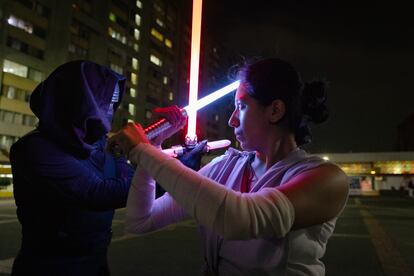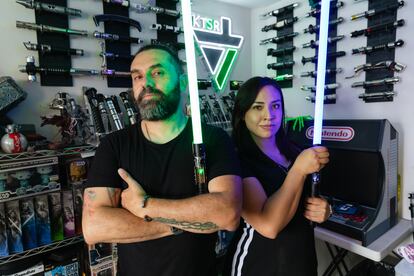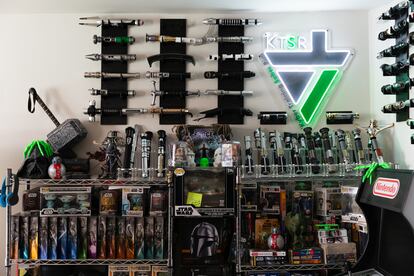In 1977, George Lucas created a universe where aliens coexist, a farmer with the dream of being a pilot, spaceships, witty androids, a princess with guts, a rogue smuggler with a heart of gold, ancient warriors guardians of peace, an empire galactic universe with a frightening villain, as well as a metaphysical and omnipresent power called The force, with its light and dark side. Little did its author imagine that this space opera, known as Star Wars, was going to become a cultural phenomenon and a saga capable of transcending and reverberating over time and on different generations around the world. Since 2011, May 4 has been marked as the international day to commemorate the popular saga, due to the phonetic similarity in English to the emblematic phrase of this universe, “May the Force be with you” (May the Force be with youin English), has with “May the 4th of May be with you” (May the Fourth be with you).
Among the buildings of the Nonoalco Tlatelolco urban complex, in the Cuauhtémoc delegation —in Mexico City—, “in a galaxy far, far away” from where the fictional events of the saga take place., Ricardo Jocksan Mejía Malvárez has created the Quetzal Combat Academya multidisciplinary school of sports and scenic lightsaber combat, where you can learn the arts of warriors Jedi either sith that can be seen in the different trilogies. Master Jocksan’s dream, as his apprentices refer to it, was born eight years ago, according to what he says, as the idea of “a ball of nerds” at a convention of Star Wars.
Jocksan, 33, is wearing an outfit characteristic of the dark side, inspired by the character of Kylo Ren. He is not what he usually trains with, but he is focused on practicing choreography to stage during a symphony concert to be held in the capital on Valentine’s Day. Star Wars. Infected by his father’s love for the work of George Lucas and his passion for martial arts since he was eight years old, he shaped the sports and recreational teaching of lightsaber.
“I started with tae kwon do, then karate, ninjutsu, kenjutsu, hema and Olympic fencing. Those are the bases of everything we see in Star Wars. We give an example. The first way known as Shii Cho [del combate jedi]is based on a two-handed sword, be it a katana, a Korean saber, a ninjatō, and a two-handed hema sword. So, there we have the martial bases to apply them to the way the sword is used in the movies,” says Mejía.
Just as in martial arts, in Quetzal students obtain degrees as they master the forms of combat with the sword, as well as complementary techniques of tai chi, kung fu, acrobatics, a little gymnastics and theater, to go from apprentice to grandmaster jedi, a process that can take approximately four to five years. Within its four locations in the capital of Chilanga, the Mejía academy has approximately 37 students in total, of which two already have a teacher’s degree and cooperate with the teaching of new students. padawanas the apprentices of these warriors are known.
Master Jocksan considers that Star Wars and the teachings around culture jedi, portrayed as guardians of order and peace in the galaxy in the movies, can be considered a philosophy of life. “The balance, between your mind and body, is within our precepts at the academy. We emphasize emotional balance. Many times you can arrive stressed, tired and this is a way to free yourself, come to play with swords, but with techniques and also in a brotherhood that embraces you,” says Mejía.

A few meters away from Jocksan, is Isadora Molina, 33 years old, teaching the basic cuts to a colleague who is beginning to take her first steps in this discipline. She is a graphic designer by profession and holds the rank of knight. jedi in Quetzal. She, along with her eight-year-old daughter, make up the 10 women who are part of the academy. In approximately two years, she aspires to reach the rank of grandmaster.
He values that it is a sport that does not distinguish between sexes and is inclusive, characteristics that he considers have been present in the franchise of Star Wars since its inception, although still, he admits, it is not very common to see a female audience 100% involved. Molina, who wears a shiny outfit that emulates the beskar – a characteristic metal that distinguishes the character in the series The Mandalorian—, says that he was a survivor of psychological abuse. As part of the therapy she carried out, they recommended that she do some type of activity that could help her in a complementary way. That’s how she arrived in Quetzal. “Violence of any kind is not allowed here. I had the advantage that Jocksan was always very friendly and cooperative. Even when they discharged me from my psychological process, they were always [sus compañeros] encouraging me, pending. Regardless of whether you are a man or a woman, the important thing is that you encourage yourself to participate, that you grow and reach a higher level,” says Molina.
A lightsaber with the toughness of a grenadier’s shield
Mejía specifies that the blades used for lightsabers are made of ballistic grade polycarbonate. They are designed for “heavy use”. “The shields of the grenadiers are made of that material. You’ve seen them throw stones at them, kick them, hit them. And that of the police officers is a little thinner. They are about 2.5 millimeters. The saber tubes are 3 millimeters. They are designed for heavy dueling, they fringe enough so that they have that flexibility,” explains Quetzal’s teacher.
Whoever provides them with their training tool is also a member of the academy. Tanit Sáenz, 47, began four years ago to become one of the main suppliers of lightsabers in Mexico. When he began practicing, they lent him the sword, but when he sought to acquire one of his own, he
found himself faced with a “quite high” price, an unreasonable delivery time, and a quality of the materials that left him with a “super bad taste in his mouth.” “It got to a point where I said, if I practice this and I like it. I have been a fan of the saga since I can remember, because I don’t open a store, because I don’t sell them myself,” he recalls.
This is how it was born KTSR Sabers, abbreviation of his son’s name (Keelan Tariq Sáenz Ríos), a lightsaber design and marketing company. His workshop and showroom —where you can take a saber to be repaired or choose different models at the moment—, located in the State of Mexico, is where Tanit Sáenz and Fernanda Ríos, his wife and who is in charge of the entire public relations area of the company, bring the magic of science fiction to reality. “We started with a few sabers, between 6 and 12. Right now we are already talking about having a stock of more than 150 for immediate delivery. We don’t play with your money. I don’t want to retransmit that bad experience that I had,” says Sáenz.

The sabers sold at KTSR range, from the most basic, between 1,700 pesos to the Elite line, which are cinematic replicas that withstand intense combat and depending on the configuration and details they carry, can go up to 15,000 and 20,000 pesos. Sáenz, who has almost 60 lightsabers decorating his wall – between his own designs and replicas – like a katana blacksmith from ancient Japan, says that he feels satisfaction for what he has achieved to date: more than 3,000 sabers sold.

Sáenz, who is a graphic designer by profession, prefers to be honest and admits that the sabers are not manufactured in Mexico and it is for a simple reason: quality and cost. “I have designed them and I have the blueprint [planos] of all the models, but they are manufactured in Asia because I couldn’t find anyone in Mexico who would manufacture them for me at a reasonable price with high quality, which is something to which we are accustomed,” he clarifies.
However, with the design of the different models they have available, they are committed to taking care of every detail in production. They have even been part of the team of developers of a card that controls all the electronic functions of the swords.
He says that his satisfaction with his work as a lightsaber designer is similar to when he saw a billboard he created displayed on some avenue. His workshop, full of swords ready for sale, others in repair, circuits, cards and buttons, demonstrate his commitment to the cause of Star Wars and the dream of many who grew up admiring the franchise. “When I see that people begin to recognize the brand, that they begin to recommend it, it is something that I really like, because I know that we are doing things well,” he concludes.
Subscribe to the EL PAÍS Mexico newsletter and to whatsapp channel and receive all the key information on current events in this country.
#Learning #Jedi #arts #owning #lightsaber #Mexico #dream #true #Star #Wars #fan